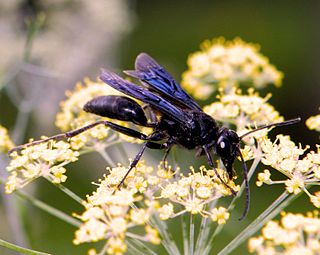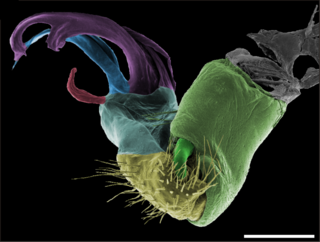
Hymenoptera is a large order of insects, comprising the sawflies, wasps, bees, and ants. Over 150,000 living species of Hymenoptera have been described, in addition to over 2,000 extinct ones. Many of the species are parasitic.

The ovipositor is a tube-like organ used by some animals, especially insects for the laying of eggs. In insects, an ovipositor consists of a maximum of three pairs of appendages. The details and morphology of the ovipositor vary, but typically its form is adapted to functions such as preparing a place for the egg, transmitting the egg, and then placing it properly. For insects, the organ is used merely to attach the egg to some surface, but for many parasitic species, it is a piercing organ as well.

The Strepsiptera are an endopterygote order of insects with nine extant families that include about 600 described species. They are endoparasites in other insects, such as bees, wasps, leafhoppers, silverfish, and cockroaches. Females of most species never emerge from the host after entering its body, finally dying inside it. The early-stage larvae do emerge because they must find an unoccupied living host, and the short-lived males must emerge to seek a receptive female in her host. They are believed to be most closely related to beetles, from which they diverged 300–350 million years ago, but do not appear in the fossil record until the Mid-Cretaceous around 100 million years ago.
Infibulation is the ritual removal of the external female genitalia and the suturing of the vulva, a practice found mainly in northeastern Africa, particularly in Djibouti, Eritrea, Ethiopia, Somalia, and Sudan. The World Health Organization refers to the procedure as Type III female genital mutilation. Infibulation can also refer to placing a clasp through the foreskin in men.

Chalcid wasps are insects within the superfamily Chalcidoidea, part of the order Hymenoptera. The superfamily contains some 22,500 known species, and an estimated total diversity of more than 500,000 species, meaning the vast majority have yet to be discovered and described. The name "chalcid" is often confused with the name "chalcidid", though the latter refers strictly to one constituent family, the Chalcididae, rather than the superfamily as a whole; accordingly, most recent publications (e.g.,) use the name "chalcidoid" when referring to members of the superfamily.

An instar is a developmental stage of arthropods, such as insects, between each moult (ecdysis), until sexual maturity is reached. Arthropods must shed the exoskeleton in order to grow or assume a new form. Differences between instars can often be seen in altered body proportions, colors, patterns, changes in the number of body segments or head width. After moulting, i.e. shedding their exoskeleton, the juvenile arthropods continue in their life cycle until they either pupate or moult again. The instar period of growth is fixed; however, in some insects, like the salvinia stem-borer moth, the number of instars depends on early larval nutrition. Some arthropods can continue to moult after sexual maturity, but the stages between these subsequent moults are generally not called instars.

The Pterygota are a subclass of insects that includes the winged insects. It also includes insect orders that are secondarily wingless.

A proleg is a small, fleshy, stub structure found on the ventral surface of the abdomen of most larval forms of insects of the order Lepidoptera, though they can also be found on other larval insects such as sawflies and a few other types of insects. In all the orders in which they appear, mainly Hymenoptera and Lepidoptera, prolegs of any form evolved independently of each other by convergent evolution.

An aedeagus is a reproductive organ of male arthropods through which they secrete sperm from the testes during copulation with a female. It can be thought of as the insect equivalent of a mammal's penis, though the comparison is fairly loose given the greater complexity of insect reproduction.

Gonopods are specialized appendages of various arthropods used in reproduction or egg-laying. In males, they facilitate the transfer of sperm from male to female during mating, and thus are a type of intromittent organ. In crustaceans and millipedes, gonopods are modified walking or swimming legs. Gonopods may be highly decorated with elaborate structures which may play roles in sperm competition, and can be used to differentiate and identify closely related species. Gonopods generally occur in one or more pairs, as opposed to the single (un-paired) reproductive organs such as the aedeagus of insects or the penis of harvestmen.

This glossary of entomology describes terms used in the formal study of insect species by entomologists.
The mesothorax is the middle of the three segments in the thorax of an insect, and bears the second pair of legs. Its principal sclerites are the mesonotum (dorsal), the mesosternum (ventral), and the mesopleuron (lateral) on each side. The mesothorax is the segment that bears the forewings in all winged insects, though sometimes these may be reduced or modified, as in beetles (Coleoptera) or Dermaptera, in which they are sclerotized to form the elytra, and the Strepsiptera, in which they are reduced to form halteres. All adult insects possess legs on the mesothorax. In some groups of insects, the mesonotum is hypertrophied, such as in Diptera, Hymenoptera, and Lepidoptera), in which the anterior portion of the mesonotum forms most of the dorsal surface of the thorax. In these orders, there is also typically a small sclerite attached to the mesonotum that covers the wing base, called the tegula. In one group of insects, the Hemiptera, the dorsal surface of the thorax is typically formed primarily of the prothorax, but also in part by the enlarged posterior portion of the mesonotum, called the scutellum; in the Coleoptera, the scutellum may or may not be visible, usually as a small triangular plate between the elytral bases, thus similar in position to the Hemipteran scutellum. In Diptera and Hymenoptera the mesothoracic scutellum is also distinct, but much smaller than the mesoscutum.

The metasoma is the posterior part of the body, or tagma, of arthropods whose body is composed of three parts, the other two being the prosoma and the mesosoma. In insects, it contains most of the digestive tract, respiratory system, and circulatory system, and the apical segments are typically modified to form genitalia. In a few of the most primitive insects, the metasomal segments bear small, articulated appendages called "styli", which are often considered to be vestigial. There are also pre-apical appendages in most insect orders, called cerci, which may be multi-segmented and almost resembling a posterior pair of antennae; these may be variously modified, or lost entirely. Otherwise, most adult insects lack appendages on the metasoma, though many larval insects have some form of appendages, such as prolegs or, in aquatic insects, gills.

The Xyelidae are a comparatively species-poor family of sawflies comprising about 80 extant species in five genera worldwide and is the only family in the superfamily Xyeloidea. The fossil record of the family is extensive, comprising more than 120 species and including the oldest fossil Hymenoptera species dating back to the Triassic, between 245 and 208 million years ago. Xyelidae are to be regarded as living fossils since they represent one of the oldest lineages of insects and include still extant forms.
An intromittent organ is a general term for an external organ of a male organism that is specialized to deliver sperm during copulation. Intromittent organs are found most often in terrestrial species, as most non-mammalian aquatic species fertilize their eggs externally, although there are exceptions. For many species in the animal kingdom, the male intromittent organ is a hallmark characteristic of internal fertilization.

The study of the genitalia of Lepidoptera is important for Lepidoptera taxonomy in addition to development, anatomy and natural history. The genitalia are complex and provide the basis for species discrimination in most families and also in family identification. The genitalia are attached onto the tenth or most distal segment of the abdomen. Lepidoptera have some of the most complex genital structures in the insect groups with a wide variety of complex spines, setae, scales and tufts in males, claspers of different shapes and different modifications of the ductus bursae in females.

Parameres are part of the external reproductive organs of male insects and the term was first used by Verhoeff in 1893 for the lateral genital lobes in Coleoptera. The primary phallic lobes which appear in the nymph or larval stages may become a pair of penes in the Ephemeroptera or a simple median penis in the Thysanura. In higher insect orders from Orthoptera to Hymenoptera, each of the primary lobes is divided into two secondary lobes or phallomeres, termed parameres and mesomeres In adult insects parameres may elongate and become genital claspers. These claspers may themselves occur in two segments, forming a proximal basimere and a distal telomere or harpago.
A telomere is a region of repetitive nucleotide sequences at each end of a chromosome.
Most insects reproduce oviparously, i.e. by laying eggs. The eggs are produced by the female in a pair of ovaries. Sperm, produced by the male in one testis or more commonly two, is transmitted to the female during mating by means of external genitalia. The sperm is stored within the female in one or more spermathecae. At the time of fertilization, the eggs travel along oviducts to be fertilized by the sperm and are then expelled from the body ("laid"), in most cases via an ovipositor.

Hymenopterida is a superorder of insects, comprising Hymenoptera and the orders of Panorpida . The superorder is a member of Endopterygota and most closely related to the orders of Neuropterida and Coleopterida.














